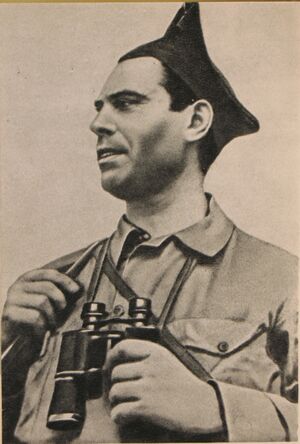Andrés Bertolo Crespo
Andrés Bertolo Crespo | |
|---|---|
| Born | August 5, 1918 Sloane, Democratic Republic of Maracaibo |
| Died | May 21, 1987 (aged 68) Altagracia, Sylvan Territory |
| Allegiance | Maracaibo |
| Service/ | Maracaibo Army Flying Corps |
| Years of service | 1941-1955 |
| Rank | Major |
| Unit | 3rd Aerial Squadron, 4th Aerial Squadron |
| Air Combats | Battle of Sloane, First Battle of Matadepera, Second Battle of Matadepera, Siege of Maracaibo City |
| Awards | Allied Nations Medal of Honor, Expert Rifleman, Joint Service Medal (2) |
Andrés Bertolo Crespo was a fighter pilot for the Democratic Republic of Maracaibo during the Pan-Septentrion War. In Maracaibo, he is regarded as a national hero. A flying ace, by the end of the war, Crespo had eleven confirmed, and four probable kills.
Early Life
Andrés Bertolo Crespo was born in the then-small industry town of Sloane to a mother and father of Sylvan origin. His mother was a seamstress and his father was a dockworker at the small riverine port. Crespo was set on leaving Maracaibo and flying one of the new commercial airline routes in Casaterra. The Pan-Septentrion War beginning in earnest put a damper on this, and he took on his father's profession until 1941.
Military Service
In 1941, Andrés signed up for the military, still eager to scratch the itch of taking to the sky. In the years prior, he'd managed to scrape together enough money from his job as a dockworker to purchase a commission. Andrés entered as an Ensign, and he put in a request to fly with the Flying Corps. He trained in one of the limited types of fighters the Army had on hand, the Hawker Fury. Although technically obsolete by the time the Pan-Septentrion War reached Meridia, Crespo maintained to his dying day that it was "not about the capability of the plane, but that of the pilot."
When tensions between the Dayashinese Empire and Maracaibo came to a head in 1943, following the breakdown of the Neutrality Deal, Crespo's squadron, the Third Aerial Squadron, was called to muster in the South. Crepso's first combat mission coincided with the first Dayashinese incursions into Maracaibo territory. Crespo observed heavily lopsided kill rates as the technologically superior Imperial planes decimated Republican air forces. During the opening days of the war, Crespo flew seven sorties, obtaining one kill, an A6M Zero during a turnfight.
As the war carried on, and the Dayashinese captured more territory, Crespo and his plane were transferred to the Fourth Aerial Squadron, based out an aerodrome less than thirty kilometers from his hometown of Sloane. This town, by now the largest industrial distribution center in the west, was planned to be the holding point for the Republican army, and it was fortified extensively.
The Battle of Sloane began in early 1944 and slogged on for several months. During this time, Crespo shot down two Ki-49 bombers, one G4M, and two A6M Zeroes. Late into the battle, a Ki-100 got the best of him and he was shot down over the city, but managed to wrest his plane to safety and land in a field nearby. This action was used as propaganda material by the Interim Government.
As the frontlines were drawn further and further back towards the capital, Crespo and the 4th Squadron were rebased to the Naval Air Base by Matadepera. Here, Crespo sortied out and met the Dayashinese at every aerial clash, downing one Ki-61 and one Ki-67. He was downed again here, by enemy anti-aircraft guns, but was again fortunate enough to regain control of the plane and land it in a field less than three kilometers from the airbase. Upon returning to his unit, he was brevetted to Major. Less than a month later, the unit was moved again after the fall of Matadepera in 1945.
At the Siege of Maracaibo, Crespo, now permanently promoted to Major, led sorties to harass Imperial gun emplacements and troop columns. In these conflicts, Crespo successfully downed two G4M bombers and one A6M Zero, with Crespo himself claiming four more kills. Imperial authority, however, had caught on to this Republican flying ace and rotated their own ace into the same theater.
On May 13th, 1945, Crespo and his squadron encountered the plane and pilot so feared about Meridia, Yuuto Onishi, the "Devil of Meridia". Boasting over two hundred combat victories, and flying in the very maneuverable Ki-100, Crespo had met his match. The two entered into a dogfight, and Onishi appeared on Crespo's tail. When the latter could not shake him, Crespo drew out his service pistol and attempted several shots behind him as he went into a nosedive, out of control. This time, his crash would not be so lucky. Crespo survived, but the use of both of his legs did not. The crash left him wheelchair-bound for the rest of his life.
Postwar Service
||||
